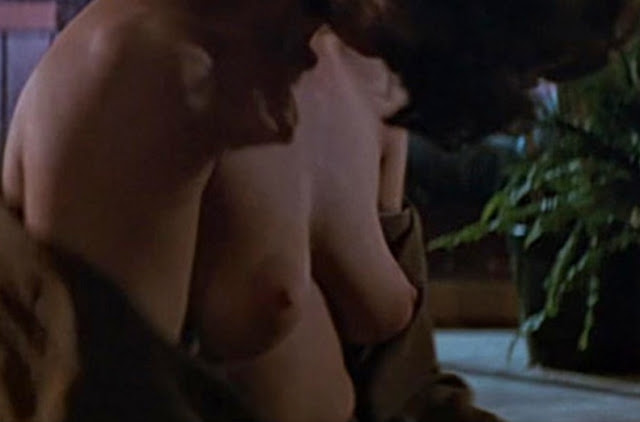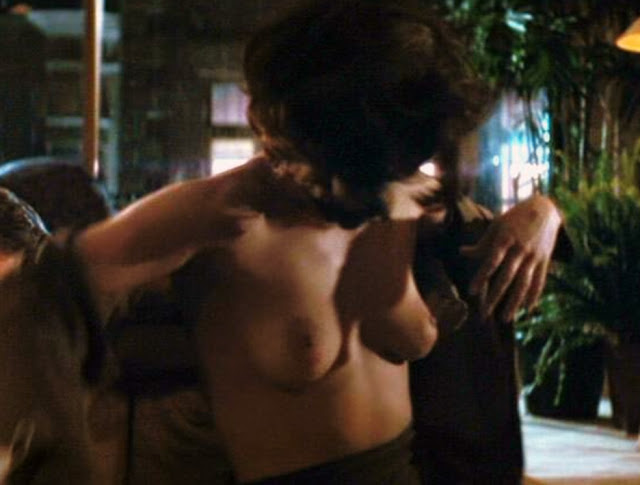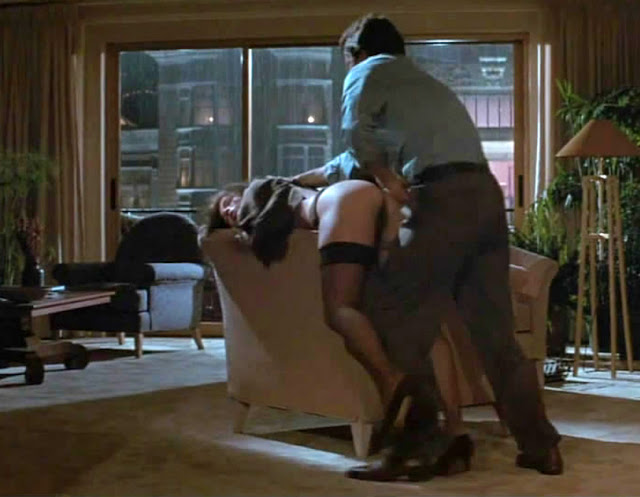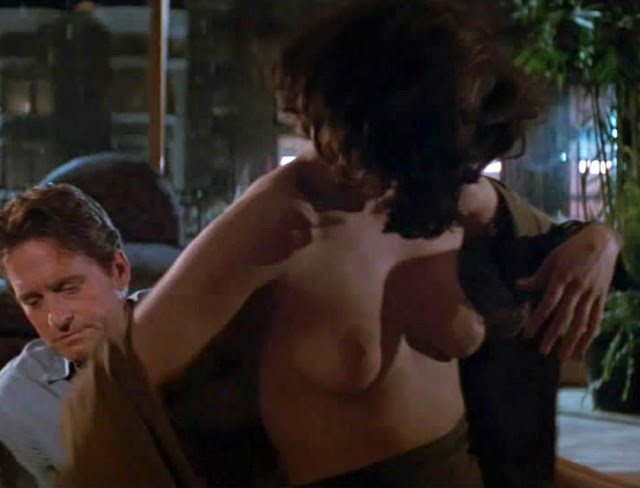The Erotic Thrillers That Followed Basic Instinct’s Success
by Simon Brew
When Basic Instinct hit big, Hollywood went hunting for more erotic thrillers. Er, it found some. Includes Kevin Spacey with odd hair.
Jean Tripplehorn (“Basic Instinct”)
-
Father, Tom Tripplehorn was a member of Gary Lewis & The Playboys / “This Diamond Ring”)
-
“Basic Instinct” (1992)
-
“The Firm” (1993)
-
“Waterworld” (1995)
-
“Big Love” (2006-2011 / TV)
Paul Verhoeven’s controversial Basic Instinct, off the back of a $3m Joe Eszterhas screenplay, brought in over $350m at the box office, at a time when that was considered an enormous amount of money. The film also made a star of Police Academy 4 alumnus Sharon Stone.
In the aftermath of Basic Instinct’s success, Hollywood went looking for more erotic thrillers, whether it be slightly repurposing movies already in the works, or actively greenlighting new ones. It took just a few years for this particular bubble to burst again. Here are the ones that followed…
When a movie hits big out of the blue, it’s unwritten Hollywood law that the imitators aren’t too far behind. That’s why, after American Pie brought Porky’s-esque sex-tinged (late) teen comedies back to prominence in 1999, the box office was flooded with similar fare for years after. The Blair Witch Project, meanwhile, hit out of nowhere, and found footage horror is only now dying away. The late Wes Craven, meanwhile, wryly noted just how quickly Hollywood had cashed in on the success of 1996’s Scream, when spoof Scary Movie popped out the year after.
Going back to 1992, though, and it was the turn of the erotic thriller to enjoy its resurgence. Paul Verhoeven’s controversial Basic Instinct, off the back of a $3m Joe Eszterhas screenplay, brought in over $350m at the box office, at a time when that was considered an enormous amount of money. The film also made a star of Police Academy 4 alumnus Sharon Stone.
In the aftermath of Basic Instinct’s success, Hollywood went looking for more erotic thrillers, whether it be slightly repurposing movies already in the works, or actively greenlighting new ones. It took just a few years for this particular bubble to burst again. Here are the ones that followed…
Consenting Adults (1992)
Alan J Pakula’s penultimate film as director was all but in the can when Basic Instinct hit big, but that still left ample time for Hollywood Pictures (owned by Disney, of course) to retune the promotional campaign for Consenting Adults ahead of its US bow in October 1992, and subsequent UK debut the following March.
The film’s not much cop, in truth, although it’s worth a gander due to its cast. You have two couples – Kevin Kline and Mary Elizabeth Mastrantonio, and Kevin Spacey and Rebecca Miller. They live next door, and Spacey’s Eddy Otis keeps teasing Kline’s Richard Parker about the idea of swapping partners. The marketing campaign duly played this up, with a scantily clad Hall on the poster, lying on top of a tagline that read ‘thou shalt not covet they neighbor’s wife’.
That’s not really – without spoiling things –what the film turns out to be about, though, with the marketing playing up a subset of its plotline. Furthermore, anyone turning up to their local Showcase expecting to be titillated and teased would have their yearnings tested by just how fruity they found Spacey’s really odd mop of hair. A curiosity at best, and one largely ignored by audiences.
Body Of Evidence (1993)

But it was not, and is not, a good film, this. As Roger Ebert put it, it’s a movie “filled with lines that only a screenwriter could love, and burdened with a plot that confuses mystery with confusion”. Whilst there’s been some recent appreciation of the movie as some kind of camp classic, most of its notoriety at the time came from the fact that Madonna was its lead, this being around the time she also launched her infamous Sex coffee table book.
The film was sold by taking a leaf out of the Consenting Adults playbook, this time with the tagline stacked above Madonna’s naked body. But box office returns were weak, Madonna’s star power in music and publishing failing to cross over into movies.
Sliver (1993)
This was supposed to be the big one. The reunion of screenwriter Joe Eszterhas with star Sharon Stone was at least part of the core Basic Instinct team, and director Phillip Noyce was brought in, hot off the back of making Patriot Games (and ahead of Clear And Present Danger).
But there were problems, and not small ones. I’ve addressed the film in more detail here – what we learned about sex in the shower from 1993’s Sliver – but it was all a bit of a flat mess. Unwisely sold with the tagline ‘you like to watch, don’t you?’, to which most critics gave the obvious answer, the film was hobbled by a notable lack of chemistry between Stone and her co-star William Baldwin.
Oftentimes, when you hear stories of stars not getting on, it’s doesn’t always translate to the screen. Here, it’s as if a ‘they hate each other’ klaxon is going off (it’s not quite at the level of Julia Roberts and Nick Nolte’s obvious loathing in 1994’s I Love Trouble, though).
The film is an adaptation of Ira Levin’s well-received novel of the same name, but producer Robert Evans got his hands on it, and declared to Eszterhas that “this movie is all about pussy”. It was Evans’ input at the start of the project, and Evans’ input at the end, involved in the recut after initial test scores from screenings came back on the low side.
The eventual film, a mess, was mauled by critics. It did turn a profit though, but its $116m worldwide gross was nearly two thirds down on the takings of Basic Instinct…
Disclosure (1994)
You don’t really associate Michael Crichton with bonkbusters, and that’s why it was something of a surprise when his novel, Disclosure, trended on Twitter before Twitter was invented. The story came to prominence off the back of a narrative strand that sees a man sue his boss for sexual harassment, when she comes on to him strongly.
Crichton’s book, and the subsequent film – directed by Barry Levinson – would be more interested in the virtual reality and cyber crime element of story. But it still sold heavily off the sex angle.
Successfully, too. The book was pretty much an instant bestseller, and Warner Bros was not coy about pushing the saucy side of things. There’s Michael Douglas’ hands on Demi Moore’s backside front and centre of the marketing, with a tagline that simply reads ‘sex is power’.
I looked back at Disclosure in more detail here. The irony is that it’s one of the most successful of the post-Basic Instinct erotic thrillers, yet it’s a film that abandons its marketing message fairly quickly, and has less that comfortable under and overtones to it. It is also about the most 1990s movie of the 1990s.
Color Of Night (1994)
Bruce Willis decided to have a go at this erotic thriller lark, figuring if Michael Douglas in a woolly jumper could inspire naughty thoughts and box office gold, then Willis would lose the knitwear, show off his Yippee Ki-Yay and hope to repeat the trick. According to IMDB trivia, Willis had a penis double, though. I didn’t attempt to verify this fact. It may be false news.
Color Of Night thus mixed in the key ingredients, of a hokum whodunit plot with some kinky stuff, as Willis and Jane March duly locked limbs. Before that, director Richard Rush and producer Andrew Vajna had locked different things as they heavily disagreed over the shape of the film’s final cut. Vajna prevailed. Early footage screened at the Cannes Film Festival elicited chortles from the watching crowd, and the film stumbled hard at the box office. And yet it overcame the snooty – and not altogether undeserved – reviews to become a hit on VHS. Willis, meanwhile, would stick a vest on again within a year, as he headed off to make Die Hard With A Vengeance.
He would not veer towards the erotic again on the big screen, although in 2013, he would screw audiences over with A Good Day To Die Hard. Boom boom!
Jade (1995) & Showgirls (1995)
If it was a Joe Eszterhas script that ignited the erotic thriller boom of the early 1990s, it was also Joe Eszterhas’ work that saw it come crashing down.
Jade came first, a $4m screenplay that William Friedkin wrestled into a movie different to the one Eszterhas envisaged. Eszterhas, in his memoir, has about as much love for Jade as the rest of the world had for it, with the October 1995 release struggling to reach $10m at the box office off a $50m budget. Critics were quick to point out similarities between the movie, and Eszterhas’s aforementioned work on Sliver and Basic Instinct.


But if Jade got a savaging, it was nothing compared to the wholesale critical destruction that Showgirls had suffered the month before. Much had been expected it of it. After all, this was the reunion of the Basic Instinct team, with Paul Verhoeven back directing a Joe Eszterhas script.
Yet whilst time has seen Showgirls attract a cult audience, the evisceration of it at its time of release was quick, brutal and loud. Pre-release hype about the film having a website that had attracted over a million hits gave way to instant claims that it was one of the worst films ever made. It isn’t, and it did actually go on to do decent business worldwide. But its loud failure had ramifications, and was arguably the ultimate catalyst in studios veering so far away from erotic thrillers for the immediate future. Yet there was still time for…
Striptease (1996)
Even as Showgirls was collapsing in cinemas, the backers of 1996’s Striptease must have been fearing the worst. Their project had made headlines for giving Demi Moore her biggest ever payday, of $12m. But it came with a condition: clothes must be shed, and she must indulge Burt Reynolds coated in Vaseline.

An easy film to slate, this, but Striptease does have a few things in its favour. Moore gives the role proper gusto for a start, and Reynolds’ bizarre Congressman David Dilbeck is actually good value. But it’s director Andrew Bergman (The Craft) and his witty script that give this a bit more flavour. Striptease is still some way off what I’d call a particularly good film, but it has moments. And I ain’t talking the mucky bits.
The movie wasn’t a massive flop – it took $113m worldwide – but it was a financial disappointment. More clothes were generally required in big budget movies in its aftermath.
What happened next?
The erotic thriller didn’t disappear, as a trip to any video shop (remember those?) in the last 1990s would testify to. But they headed out of the mainstream again for a while, primarily headed out of cinemas altogether, and certainly went lower profile. A few films broke through – David Cronenberg’s Crash was technically listed as an erotic thriller, and the Wachowski’s breakthrough film, Bound – but they were exceptions rather than the rule.
It arguably took until the 50 Shades Of Grey movie for fruity stuff to go heavily mainstream again. There’ll be more of that later this month too, when 50 Shades Darker heads to darkened rooms full of people around the country…
A couple of extra mentions
Released around the time of the erotic thriller boom was Louis Malle’s Damage, starring Jeremy Irons. This was an unrelated feature, though, and hardly competing on the same ground. One curio, though, is 1994’s Exit To Eden, from Garry Marshall, the director of Pretty Woman. Based on an Anne Rice novel, this was a comedy thriller about two cops at an S&M retreat. The cast, featuring Rosie O’Donnell, Dan Aykroyd and Paul Mercurio, battled gamely on. Few turned up to watch them, though….
“Basic Instinct” 2017?
.jpg)
.jpg)
.jpg)
.jpg)
.jpg)
.jpg)
.jpg)

.jpg)
.jpg)
+-+Copy.jpg)
+-+Copy.jpg)
.jpg)
.jpg)
.jpg)
.jpg)
.jpg)
.jpg)
.jpg)
.jpg)
.jpg)


.jpg)



 10 Rare Nudes #10 – Justine Bateman, Blake Lively, Olivia Munn etc
10 Rare Nudes #10 – Justine Bateman, Blake Lively, Olivia Munn etc